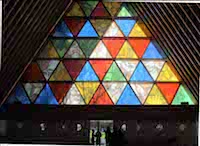 Over the years we’ve had some great times in Christchurch but after the earthquake we avoided going back. Now nearly 4 years on we decided to return although I still had mixed feelings about seeing this wounded city at first hand.
Over the years we’ve had some great times in Christchurch but after the earthquake we avoided going back. Now nearly 4 years on we decided to return although I still had mixed feelings about seeing this wounded city at first hand.
The Transitional Cardboard Cathedral
We wanted to focus on the positive, so set off with two Cantabrians, sister Hanna and brother-in- law Alan to visit the Transitional Cardboard Cathedral. Japanese architect Shigeru Ban who has built temporary buildings in post disaster centres all over the world designed it for free. This stunning symbol of hope and resiliency is his largest structure to date and can sit 700 people.
But why choose cardboard? Ban’s philosophy is that concrete buildings may look tough but can crumble easily in an earthquake, while paper will stand and it is also a cheap and sustainable material.
A band of cheerful volunteers were at the entrance to welcome visitors. The organist took us under his wing. He walked and talked us through the cathedral pointing out how the images on the brilliantly coloured stained glass windows were copied from the original Christchurch Cathedral’s rose window. The 320 cardboard tubes are actually made from industrial strength cardboard with laminated wood inserts.
We paused at a little chapel at the side of the cathedral made out of some of the containers on which the cardboard tubes rest. Then he walked us to the electronic organ, sat down to explain its inner workings and played a few tunes. The joyous sounds of organ music briefly filled the cathedral.
From the Transitional Cardboard Cathedral it was only a short walk to Cathedral Square. On the way we passed a very moving installation in a vacant lot: 185 empty hand painted white chairs all different shapes and sizes to commemorate the uniqueness of each person who died in the earthquake. The green grass growing underneath is a symbol of regeneration
In the CBD the devastation wrought by the quake was still clearly visible. Although most of the rubble has been cleared, there are many open gravelly spaces where buildings once stood. Quite a few of those that are left standing look ragged at the edges.
Cathedral Square
In the square the shattered Cathedral which has lost its spire was an especially heart breaking sight.
Artist Sarah Hughes has hung a wall of 684 brightly coloured flags between the flagpoles left standing after the earthquake. Her wish is that as they catch the wind they will blow optimism and good will back into the square.
On a large mural in front of the Cathedral Chris Heaphy has painted signs, symbols and geometric architectural elements. Their bright colours pop out against the black background. A small whare with living plants is part of it which alludes to the ancient history of this place. Ancestral Ngai Tahu bones lie under the Foundation of the Cathedral.
Sadly the Christchurch Wizard in his pointy black hat no longer holds forth there. Devastated by the quake he told a reporter that repairs to his beloved city were beyond his wildest powers. So he departed taking his 91 year old mother with him to live in Oamaru.
The Queen Elizabeth Arts Centre
We walked on to the nearby Queen Elizabeth Arts Centre which in prequake days was always jam packed with visitors eating in cafes and perusing the many arts and crafts for sale. On this Saturday it was very quiet, and only one small outdoors craft market was open. But the renovation of the buildings is well on the way. It shouldn’t be too long now before the Arts Centre is back in action.
Riccarton Farmer’s market
Ready for a coffee and a bite to eat we drove the 3.5 kilometers to the Riccarton Farmers’ Saturday market held right beside the grand historic Riccarton House and cottage where the pioneering Deans family made their home.
Revived by a take-away coffee we joined the crowds and wandered happily around the market impressed by the variety of locally produced goods on sale including posh porridge, smoked salmon, fresh fruits and vegetables and an irresistible selection of freshly baked treats.,
Christchurch has always had its share of excellent Dutch baking and we were delighted to find a large round of traditional Dutch boterkoek which we demolished between us for morning tea.
We took a short walk through the small patch of native forest in the adjacent bush under 600 year old kahikatea trees. Then we gathered up a picnic lunch: cups of homemade watercress and Jerusalem artichoke soup and buns filled with German sausages. And sat on a bench by the gently flowing Avon River and watched the ducks.
Our visit to Christchurch was all too brief. Next time I’d love to visit Re-Start the container mall in the heart of the city where the shops are housed in brightly coloured shipping containers.
I was glad we went back. We’ve seen Christchurch CBD as it is now and can look forward to future visits when we’ll see its gradual transformation into a new and beautiful city.









Join the Discussion
Type out your comment here:
You must be logged in to post a comment.